Termez
Termez
Termiz / Термиз | |
|---|---|
 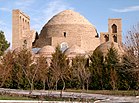      | |
 Termez Location in Uzbekistan | |
| Coordinates: 37°13′N 67°17′E / 37.217°N 67.283°ECoordinates: 37°13′N 67°17′E / 37.217°N 67.283°E | |
| Country | |
| Region | Surxondaryo Region |
| Established | 1929 |
| Government | |
| • Type | City Administration |
| Area | |
| • Total | 36 km2 (14 sq mi) |
| Elevation | 302 m (991 ft) |
| Population (2014) | |
| • Total | 136,200 |
| • Density | 3,800/km2 (9,800/sq mi) |
| Postal code | 190100 |
Termez (Uzbek: Termiz/Термиз; Tajik: Тирмиз; Persian: ترمذ Termez, Tirmiz; Arabic: ترمذ Tirmidh; Russian: Термез; Ancient Greek: Tàrmita, Thàrmis, Θέρμις) is a city in southern Uzbekistan, near the Hairatan border crossing with Afghanistan. It is the capital of Surxondaryo Region.
Etymology[]
Some link the name of the city to the Greek word Θέρμος (thermos), meaning "hot", and date the toponym to the rule of Alexander the Great.[1] Others suggest that it came from Sanskrit तर्मतो (taramato), meaning "on the river bank".[2]
History[]
Ancient times[]
One of Central Asia's oldest towns, Old Termez, located a few kilometers west of the modern city along the Amu Darya river, was established sometime before the 3rd century BC.[3] The city may have been known to the Achaemenids (the 10th century Shahnameh purports its existence during the mythological Zoroastrian Kayanian dynasty[4]). In April 2002, the city held a celebration of its 2,500th anniversary.[5]

In 329 BC Alexander the Great conquered the surrounding region, known as Sogdia. Most recent scholarship argues that Termez is the site of Alexandria on the Oxus,[6] though some identify this site with Ai-Khanoum. After a period of Seleucid rule, Termez became part of the breakaway Greco-Bactrian Kingdom. The Ionian Greek language persisted in the area through the Tocharian period, being phased out of administrative use during the time of the Kushan Empire, in favor of the Bactrian language.[7]
It was during this period that Termez, named Ta-li-mi (迭里迷) in Chinese sources, became an important center of Buddhism.[8]
Termez was incorporated into the Sassanid Persian Empire in the 3rd century AD, and fell to the Hephtalites in the 6th.
During the 7th century Termez played host to the Buddhist monk and traveler Xuanzang, who reported:
There are about ten Sangharamas with about one thousand monks. The stupas and the images of the honoured Buddha are noted for various spiritual manifestations.
— Xuanzang, Great Tang Records on the Western Regions
In the three decades that followed, as the Umayyads conquered the Persians, Termez found itself across the river from the caliphate.
Islamic Age[]
This section needs additional citations for verification. (August 2021) |
In 705 the city was conquered by the Umayyad Caliphate.
It again rose to religious significance during the Abbasid and Samanid Empires, producing notable scholars such as hadith collector Imam Al-Tirmidhi and Sufi master and theologian Al-Hakim al-Tirmidhi.
As Termez passed through the hands of the Ghaznavid, Seljuk, Karakhanid, and Khorezmshah kingdoms from the 9th to 13th centuries, it enjoyed prominence as a center of culture and trade, and had fortified walls running the length of 16 kilometres (10 miles), with nine gates.
In 1220 after a two-day siege, the city was destroyed by the troops of Genghis Khan. According to one account, "all the people, both men and women, were driven out onto the plain, and divided in accordance with their [the Mongols'] usual custom, then they were all slain."[9]
Ibn Battuta found the city reconstructed in the early 14th century:
We set out from Samarqand and reached Tirmidh [Termez], a large town with fine buildings and bazaars and traversed by canals. It abounds in grapes and quinces of an exquisite flavour, as well as in flesh-meats and milk. The inhabitants wash their heads in the bath with milk instead of fuller's earth; the proprietor of every bath-house has large jars filled with milk, and each man as he enters takes a cupful to wash his head. It makes the hair fresh and glossy . . . The old town of Tirmidh was built on the bank of the Oxus, and when it was laid in ruins by Tinklz [Chingiz] this new town was built two miles from the river.
— Ibn Battuta Travels in Asia And Africa 1325–1354
The restored Termez was soon conquered by Tamerlane's Timurid Empire, which held the territory until it was annexed by the Emirate of Bukhara in the 16th century.
By the second half of the 18th century the city was again abandoned, and the ruins of the reconstituted Termez laid outside the nearby villages of Salavat and Pattakesar (Pattagissar).
In the Russian Empire and the Soviet Union[]

This section does not cite any sources. (August 2021) |
In January 1893 the Emirate of Bukhara gave the land of the village Pattakesar to the Russian Empire to build a fortress, garrison, and river port on the border.
In 1928 as part of the Soviet Union, Pattakesar was renamed and took the city's ancient name of Termez. In 1929, the village became a town.
During the years of Soviet rule, industry was built and a Pedagogical Institute and a theatre were opened.
For many years after the Second World War the 108th Motor Rifle Division, the former 360th Rifle Division, was based in the town.
During the Soviet–Afghan War (1979–1989), Termez was an important military base; over 100,000 Soviet troops were based there. A military airfield and the Afghanistan–Uzbekistan Friendship Bridge, a combined bridge over the Amu Darya, were built.
Independent Uzbekistan[]
In 1992 the Pedagogical Institute was upgraded to Termez State University.
In 2001, Germany began operating a base in Termez. The military airfield was the main support base for German and Dutch forces operating with the ISAF for transiting goods into Afghanistan. It was closed in 2015.[10]
In July 2009, it was decided to establish a "Termez regional railway junction" which will be one of the main places in the planned transit of non-lethal NATO supplies to Afghanistan. The transit will be through Russia, Kazakhstan and Uzbekistan bypassing Turkmenistan through the railway in 2009 -Boysun-Kumkurgan.[citation needed]
In June 2015, the Prime Minister of Pakistan, Nawaz Sharif, announced the construction of the Gwadar–Termez Highway, which would connect Uzbekistan via a road network to the Arabian Sea at Gwadar Port in Pakistan.[11]
On 2 July 2021, the Biden administration reached out to Uzbekistan, as well as Kazakhstan and Tajikistan, to ask if they might temporarily accommodate up to 9,000 Afghans who might face reprisals for working with U.S. military forces.[12] By 5 July, the state security services had constructed a refugee camp in Termez to brace for an Afghan refugee crisis.[13]
Cultural and historical sites[]
- Termez Archaeological Museum opened in 2002 to commemorate the 2,500th anniversary of Termez.[5] It exhibits archaeological finds and other historic artefacts from sites across Surxondaryo Region. The modern building has a turquoise domed roof and an attractively tiled facade. It is one of the largest and best museums in Uzbekistan.[14] There are around 27,000 items in the collection.[5]
- Much of the museum's collection focuses on Termez's Buddhist history, in particular the Graeco-Bactrian and Kushan eras. There are scale models of archeological sites including Kampir Tepe, Fayaz Tepe, and Khalchayan; and magnificent wall paintings and sculptures, as well as coins, ceramics, and even ancient chess sets.[15]
- Kyr Kyz (The 40 Girls Fortress) takes its name from a Central Asian legend about a princess and her 40 companions who defended their land against invaders.[16] Although this monument is called a fortress, archeologists believe it was actually either a caravanserai or a summer palace.[14] It was built during the 9th century in the Samanid period. Although it is now in ruins, it is still possible to see the 54m long mud brick walls, which in places are two storeys high. One section has been restored so you are able to compare the old and the new.[14]
- The Al Hakim At-Termizi architectural complex dates from the 10th to 15th centuries. It is centred on the mud brick mausoleum of Al Hakim At-Termizi, a Sufi saint, jurist, and writer who died in Termez in 859. The site was expanded and improved at the instigation of Timur's son, Shah Rukh, in the 15th century.[14]
- The Sultan Saodat architectural ensemble developed in stages between the 10th and 17th centuries. It was the family necropolis of the Termez Sayyids, a politically and religiously influential local dynasty which claimed descent from Ali. There are approximately 120 graves in the complex, as well as a number of religious buildings. The mortar holding the mud bricks together is an unusual mixture of clay, egg yolk, camels’ blood, and milk. There are pre-Islamic decorative symbols on some of the buildings, including a Zorastrian star motif which represents infinity and fertility.
- The Kokil Dara Khanagha was built by Abdullah Khan II of Bukhara in the 16th century. The building was created as a resting place for itinerant Sufi dervishes and other holy men. It has cultural links with various buildings in Afghanistan, including the styling of the vaulted ceiling. There is no central courtyard as this order of Sufis didn't whirl, but instead focused on quiet, solitary meditation.[14]
- Kara Tepe is a rock cut Buddhist temple complex founded in the 2nd century AD on the hills outside Termez. It is right on the Uzbek–Afghan border, and so a permit is required to visit.[14] The site includes cave cells (which were used as burial sites once the temple was abandoned in the 4th century), a series of brick buildings, and small stupas. It is similar in design to other Buddhist temples built in Gandhara.[17]
- Fayaz Tepe is a Buddhist monastery, most of which dates from the 1st to 3rd centuries AD. The main stupa (which is now encased in a protective dome) could be much older.[14] Fayaz Tepe was a regionally important site, attracting Buddhist scholars from along the Silk Road, as is evidenced by pottery finds inscribed with Brahmi, Punjabi, Kharosthi, and Bactrian scripts.[14] The Buddhist frescoes excavated here are now on display in the State Museum of History of Uzbekistan in Tashkent.[18]
- The Zurmala Stupa is one of the oldest surviving buildings in Uzbekistan, dating from the 1st to 2nd centuries AD. Its brick structure is 16m high and is the only remaining part of a vast Buddhist stupa which would have been originally clad in stone and richly decorated.[14]
- Kampir Tepe was a substantial city built on the Amu Darya river by Alexander the Great. Known as Alexandria on the Oxus, the city had an important harbour with a lighthouse, as well as a citadel, temples, and a gateway that is a replica of one found in Pamphylia in Turkey. The site is still being excavated by archeologists but is open to the public.
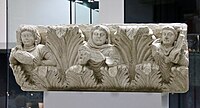
Greco-Buddhist frieze showing musicians, in the style of Gandhara.
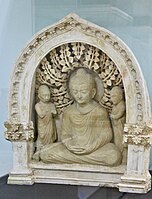
The Buddha and attendants (original in the State Museum of History of Uzbekistan, Tashkent).
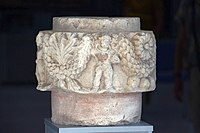
Capital with Classical Garland bearers, 100-200 CE.

Saka warrior from the site of Khalchayan. Art of the Yuezhi.
Transportation[]
The river Amu Darya divides the two countries of Uzbekistan and Afghanistan and the Afghanistan–Uzbekistan Friendship Bridge crosses the river to Hairatan in Afghanistan. Termez is also served by Termez Airport, with flights to Tashkent and Moscow. Termez is connected with Uzbek Railways to other cities of the countries and Mazar-i-Sharif, Afghanistan. Tashkent–Termez (no. 379) and Termez–Tashkent (no. 380) train runs every day.[19] Dushanbe–Kanibadam (no. 367) and Kanibadam-Dushanbe (No: 368) trains also pass through Termez.
Demographics[]
The officially registered population of Termez in 2005 was 140,404. Uzbeks and Tajiks are the largest ethnic groups.
Climate[]
Termez has a cold desert climate (BWk) with very hot, long summers and short, cool winters.
| hideClimate data for Termez (1981–2010, extremes 1936–present) | |||||||||||||
|---|---|---|---|---|---|---|---|---|---|---|---|---|---|
| Month | Jan | Feb | Mar | Apr | May | Jun | Jul | Aug | Sep | Oct | Nov | Dec | Year |
| Record high °C (°F) | 23.9 (75.0) |
30.1 (86.2) |
37.3 (99.1) |
38.7 (101.7) |
43.6 (110.5) |
46.5 (115.7) |
47.0 (116.6) |
46.3 (115.3) |
41.5 (106.7) |
37.5 (99.5) |
33.5 (92.3) |
26.7 (80.1) |
47.0 (116.6) |
| Average high °C (°F) | 10.4 (50.7) |
13.2 (55.8) |
18.9 (66.0) |
26.6 (79.9) |
32.8 (91.0) |
38.0 (100.4) |
39.7 (103.5) |
38.0 (100.4) |
32.8 (91.0) |
25.8 (78.4) |
18.8 (65.8) |
12.1 (53.8) |
25.6 (78.1) |
| Daily mean °C (°F) | 4.2 (39.6) |
6.7 (44.1) |
12.1 (53.8) |
18.9 (66.0) |
24.6 (76.3) |
29.1 (84.4) |
30.5 (86.9) |
28.4 (83.1) |
22.9 (73.2) |
16.5 (61.7) |
10.8 (51.4) |
5.7 (42.3) |
17.5 (63.5) |
| Average low °C (°F) | −0.3 (31.5) |
1.6 (34.9) |
6.5 (43.7) |
12.1 (53.8) |
16.5 (61.7) |
19.9 (67.8) |
21.5 (70.7) |
19.4 (66.9) |
14.1 (57.4) |
8.8 (47.8) |
4.8 (40.6) |
1.0 (33.8) |
10.5 (50.9) |
| Record low °C (°F) | −23.9 (−11.0) |
−21.7 (−7.1) |
−7.9 (17.8) |
−2.0 (28.4) |
−0.1 (31.8) |
11.4 (52.5) |
12.9 (55.2) |
9.3 (48.7) |
4.6 (40.3) |
−4.2 (24.4) |
−11.0 (12.2) |
−18.4 (−1.1) |
−21.7 (−7.1) |
| Average precipitation mm (inches) | 24.3 (0.96) |
23.7 (0.93) |
36.4 (1.43) |
23.5 (0.93) |
9.5 (0.37) |
1.5 (0.06) |
0.2 (0.01) |
0.0 (0.0) |
0.5 (0.02) |
3.2 (0.13) |
11.1 (0.44) |
20.5 (0.81) |
154.4 (6.09) |
| Average precipitation days | 10 | 11 | 11 | 8 | 5 | 1 | 1 | 0 | 1 | 3 | 6 | 9 | 66 |
| Average snowy days | 4 | 3 | 1 | 0.03 | 0.1 | 0 | 0 | 0 | 0.03 | 0.1 | 1 | 3 | 12 |
| Average relative humidity (%) | 77 | 71 | 66 | 57 | 45 | 36 | 36 | 38 | 45 | 53 | 65 | 76 | 55 |
| Mean monthly sunshine hours | 139.5 | 144.1 | 189.1 | 246.0 | 334.8 | 375.0 | 384.4 | 362.7 | 315.0 | 257.3 | 195.0 | 139.5 | 3,082.4 |
| Mean daily sunshine hours | 4.5 | 5.1 | 6.1 | 8.2 | 10.8 | 12.5 | 12.4 | 11.7 | 10.5 | 8.3 | 6.5 | 4.5 | 8.4 |
| Source 1: Centre of Hydrometeorological Service of Uzbekistan[20] | |||||||||||||
| Source 2: Pogoda.ru.net (mean temperatures/humidity/snow days 1981–2010, record low and record high temperatures),[21] Deutscher Wetterdienst (sun 1961–1990)[22] | |||||||||||||
Notable people of Termez[]
- Its most famous native son is Al-Tirmidhi, born in its suburb Bugh and buried 60 kilometers north of Termez, on the outskirts of Sherobod, Uzbekistan. He is one of the six canonical hadith collectors of Sunni Islam. He is locally known as Abu Isa at Termezi.
- Hakim-at-Termizi, one of the famous Sufi theologians, is buried in old Termez which is in the suburbs of modern Termez. He is also known as Termez Ota (a patron saint of Termez).
- Sayyid Ali Akbar was an Islamic saint, the son of the eleventh Shia Imam, Hasan al-Askari and the brother of the twelfth Imam, Muhammad al-Mahdi. Sayyid Ali Akbar is Sultan Saadat (Sodot) who died in Termez. His burial place is located in the main mausoleum Sultan Saodat memorial complex in Termez.
- Adib Sabir, 12th-century Persian poet
- Said Baraka was from old Termez. He was a philosopher, war strategist and religious nobleman, and Amir Temur's teacher.
- Ali Termezi known as "Pir Baba" was a Sayyid born in Termez, (1502–1583 CE). His mausoleum is in a village named Pir Baba after him in Buner District of Khyber Pakhtunkhwa, Pakistan.
- Valery Khalilov (1952–2016) was born in Termez. He was a Russian general and a composer.
Main historical sights[]
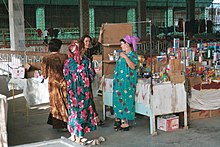
- Kyrk-Kyz Fortress (out-of-town Palace Country Estate) (9th–14th centuries)
- Palace of Termez rulers (11th–12th centuries)
- Architectural Complex of Al Hakim At-Termizi (10th–15th centuries)
- Architectural Ensemble Sultan Saodat (10th–18th centuries)
- Kokildora Khanaka (16th century)
- Kara Tepe Buddhist Monastery (2nd–4th centuries)
- Fayaz Tepe Buddhist Monastery (1st–3rd centuries)
- Zurmala Tower (1st–2nd century AD)
- Abu Isa At-Tirmidhi Mausoleum (9th century AD), in the suburb of Sherobod, 60 kilometers north of Termez.
- Zul Kifl Mausoleum in the island Aral-Paygambar on the Amu Darya river. It is not possible to access it at the moment since it is in the military zone and the restricted nature reserve.
See also[]
References[]
- ^ E. M. Pospelov, Geograficheskie nazvaniya mira (Moscow, 1998), p. 415: "here in fact is found the hottest place in Central Asia (in June 1914 a temperature of 49.5 C was recorded in Termez."
- ^ Sh. Kamaliddinov, Istoricheskaya geografiya Sogda i Toharistana. 1996. ISBN 978-5640020885
- ^ Rtveladze, E. V. (1994). Kampir-tepe: Structures, written documents, and coins. Bulletin of the Asia Institute, 8, 141–154.
- ^ ز سومان و ترمذ و ویسه گرد / سپاهی برآمد ز هر سوی گرد
- ^ Jump up to: a b c "Archeology Museum, Termez, Uzbekistan". uzbek-travel.com. Retrieved 1 November 2020.
- ^ Edvard Rtveladze. Кампыртепа – Александрия Оксианская: город-крепость на берегу Окса в эллинистическое и постэллинистическое время (конец IV в. до н.э.- I в. до н.э.) [Kampyrtepa – Alexandria Oxiana : The city and fortress on the Oxus in the Hellenistic and post-Hellenistic epochs (from late 4th till 1st century BC)]. Материалы тохаристанской экспедиции Х. Ахеологические исследования Кампыртепа [Materials of the Tocharistan expedition X. Archeological research of Kampyrtepa], Tashkent : San’at, 2017, 148 p.
- ^ Falk, Harry (2001). "The yuga of Sphujiddhvaja and the era of the Kuṣāṇas". Silk Road Art and Archaeology VII. pp. 121–136.
- ^ Esparraguera, J. M. G., Gil, E. A., Ferreras, V. M., & Pidaev, S. R. (2015). The Buddhist occupation of Tchingiz Tepe (Termez, Uzbekistan) in the Kushan period through the ceramic contexts. Archaeological Research in Asia, 3, 19–33. doi:10.1016/j.ara.2015.04.003
- ^ "Central Asian world cities". Faculty.washington.edu. 29 September 2007. Archived from the original on 18 January 2012. Retrieved 14 April 2012.
- ^ https://www.rferl.org/a/uzbekistan-germany-to-shut-base-last-western-in-central-asia/27308248.html Retrieved 10 May 2021
- ^ Routes to Central Asia being constructed, says Nawaz Dawn News, Pakistan
- ^ www.bloomberg.com https://www.bloomberg.com/news/articles/2021-07-02/u-s-asks-central-asian-nations-to-take-afghans-seeking-visas. Retrieved 5 July 2021. Missing or empty
|title=(help) - ^ "Uzbekistan bracing for possible Afghan refugee crisis | Eurasianet". eurasianet.org. Retrieved 5 July 2021.
- ^ Jump up to: a b c d e f g h i Ibbotson, Sophie (2020). Uzbekistan. United Kingdom: Bradt Guides Ltd. pp. 202–205. ISBN 9-781784-771089.
- ^ "Archaeological Museum of Termez". Caravanistan. Retrieved 1 November 2020.
- ^ "Qyrq Qyz (Forty Girls) | Aga Khan Development Network". www.akdn.org. Retrieved 1 November 2020.
- ^ History of civilizations of Central Asia. Dani, Ahmad Hasan., Masson, V. M. (Vadim Mikhaĭlovich), 1929–, Harmatta, J. (János), 1917–2004., Litvinovskiĭ, B. A. (Boris Abramovich), Bosworth, Clifford Edmund., Unesco. (1st Indian ed.). Delhi: Motilal Banarsidass Publishers. 1999. ISBN 81-208-1409-6. OCLC 43545117.CS1 maint: others (link)
- ^ Lukonin, Vladimir Grigorʹevich. (2013). Central Asian art. Ivanov, Anatoly. New York: Parkstone Press International. ISBN 978-1-78042-894-9. OCLC 859157465.
- ^ "Uzbekistan Railways".
- ^ "Average monthly data about air temperature and precipitation in 13 regional centers of the Republic of Uzbekistan over period from 1981 to 2010". Centre of Hydrometeorological Service of the Republic of Uzbekistan (Uzhydromet). Archived from the original on 15 December 2019. Retrieved 15 December 2019.
- ^ "Weather and Climate – The Climate of Termez" (in Russian). Weather and Climate (Погода и климат). Archived from the original on 6 December 2016. Retrieved 6 December 2016.
- ^ "Klimatafel von Termis (Termez) / Usbekistan" (PDF). Baseline climate means (1961–1990) from stations all over the world (in German). Deutscher Wetterdienst. Retrieved 9 June 2017.
External links[]
| Wikimedia Commons has media related to Termez. |
- Populated places in Surxondaryo Region
- Populated places along the Silk Road
- Afghanistan–Uzbekistan border crossings
- World Heritage Tentative List
- Cities founded by Alexander the Great







